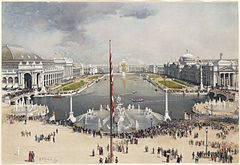
Back City Beautiful Movement Spanish جنبش شهر زیبا Persian City Beautiful French תנועת סיטי ביוטיפול HE 都市美運動 Japanese ქალაქი-მშვენიერი Georgian City Beautiful-beweging Dutch City Beautiful Movement Portuguese City Beautiful Russian 城市美化运动 Chinese

The City Beautiful movement was a reform philosophy of North American architecture and urban planning that flourished during the 1890s and 1900s with the intent of introducing beautification and monumental grandeur in cities. It was a part of the progressive social reform movement in North America under the leadership of the upper-middle class, which was concerned with poor living conditions in all major cities.[1] The movement, which was originally associated mainly with Chicago, Cleveland, Detroit, Kansas City and Washington, D.C., promoted beauty not only for its own sake, but also to create moral and civic virtue among urban populations.[2]
Advocates of the philosophy believed that such beautification could promote a harmonious social order that would increase the quality of life, while critics would complain that the movement was overly concerned with aesthetics at the expense of social reform; Jane Jacobs referred to the movement as an "architectural design cult."[3]
- ^ Caves, R. W. (2004). Encyclopedia of the City. Routledge. p. 103.
- ^ Daniel M. Bluestone, Columbia University, (September 1988). Detroit's City Beautiful and the Problem of Commerce Journal of the Society of Architectural Historians, Vol. XLVII, No. 3, pp. 245-62.
- ^ Jacobs, Jane. The Death and Life of Great American Cities (New York: Random House, 1961), p.375; quoted in Rybczynski, Witold. City Life: Urban Expectations in a New World New York: Scribner, 1995. p.27. ISBN 0-684-81302-5.
© MMXXIII Rich X Search. We shall prevail. All rights reserved. Rich X Search